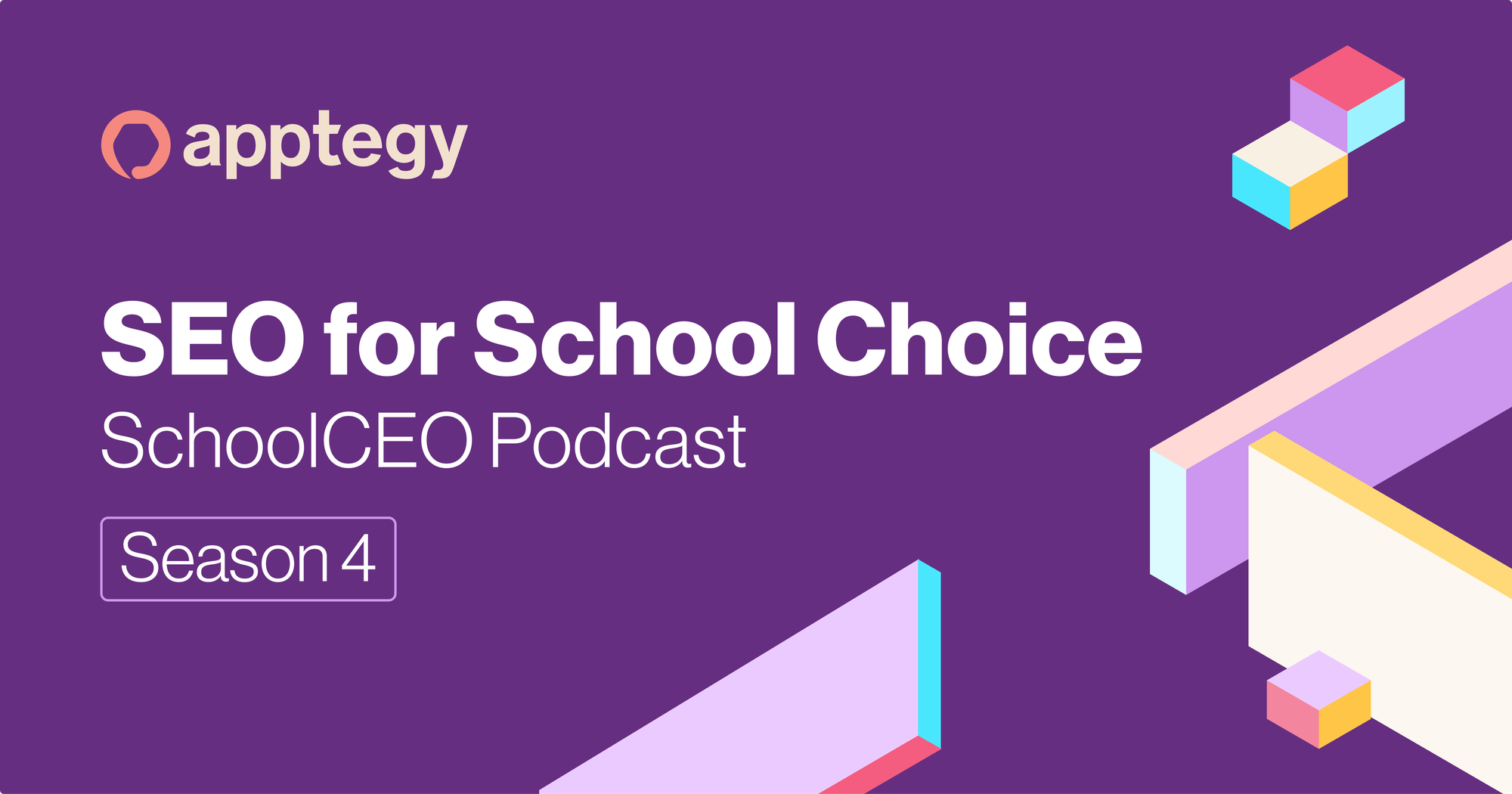SEO for School Choice
Today we discuss school choice and how to use SEO to create awareness.

Show Notes:
Check out our piece on the awareness phase of enrollment marketing.
Read Designing a Communication Survey for tips on creating your own.
Subscribe to our newsletter at https://www.schoolceo.com/subscribe-now/.
Visit us at schoolceo.com and connect with SchoolCEO on LinkedIn or X/Twitter @school_ceo. If you have a story you’d like to share with the SchoolCEO team, email us at eileen@schoolceo.com or schedule a call.
SchoolCEO is powered by Apptegy, the maker of the leading K-12 communications and brand management platform.
Episode Transcript
Welcome to the SchoolCEO Podcast. I’m your host, Eileen Beard. So far this season, we’ve dived into a SWOT analysis—which stands for Strengths, Weaknesses, Opportunities and Threats—of every school communications department in the country. Most, if not all of you, share a lot of them in common. Your strengths are your people. The kids are the reason you all do this in the first place. Educators and school administrators are some of the most passionate people on the planet. Everywhere you look in K12, you’ll find stories of learning and joy and hope and connection. And of course the key to school marketing is amplifying them. But a lot of so-called “weaknesses” or vulnerabilities make it difficult for school comms teams to do that—small teams and small budgets being two of the biggest obstacles many of you face. But a weakness is also an opportunity to think outside of the box. We’ve discussed several different opportunities that exist to increase the capacity of school comms—namely, inviting students, staff and parents to help tell your stories and broadcast those strengths.
Now, we’re going to talk about the T in SWOT—threats. Think of these as outside factors that make your work more difficult. And we’re going to start with a big one—school choice. Some of you work in states with a universal voucher system, which means private, religious or charter schools may be pulling students and funds from your schools. The number of children being homeschooled has increased since the pandemic, making it another threat to funding and enrollment. Even in states where parents aren’t rewarded for pulling children out of the public school system, private schools still tend to have more money and a bigger marketing budget to attract new students and staff.
So, what do you do about it? Well, the first step is to create awareness.
The Awareness phase of the customer journey isn’t just sharing information about your district when people ask for it. It’s about getting out into the community. It’s also making sure your community knows that your district is an option for them. Do families know they can choose to enroll their children in your schools even if they aren’t zoned for your district? What is your process for enrolling?
There are many ways to create awareness, but today let’s focus on one tactic in particular: leveraging search engine optimization or SEO to create awareness online. Why?
Because today, when new parents are choosing a district, most go online before ever setting foot in your schools. So in order to get out into your community, you need to get in their search results.
That’s why Erin Dunsey, communications manager for Peoria Unified School District in Arizona, took an interest in SEO. Peoria Unified had seen a recent drop in kindergarten enrollment, so Dunsey went online and searched “kindergarten peoria”. They weren’t on page 1 or even page 2—Dunsey says they were somewhere around page 20. While they could have reviewed Google Analytics data or researched optimization best practices, their approach was actually far simpler.
Peoria Unified conducted a survey asking preschool and kindergarten parents what factors they thought about when deciding where to send their kids to school. Dunsey compared these survey results to what she was seeing on competing schools’ homepages, specifically those that were appearing on the first few pages of Google’s search results. Dunsey found a lot of commonalities. Some of them centered around high-quality teachers. She also saw that school safety and rigorous curriculum seemed to be important to families in Peoria.
All of those things were on Peoria Unified’s website, but they weren’t necessarily prominent. So on the kindergarten page of Peoria Unified’s website, the communications team began highlighting the concerns that were both important to families and also ranked highly on Google.
Later, Dunsey checked back to see whether her team’s work had impacted their website’s visibility and found that they’d gone from somewhere around page 20 to page 2.
If your website isn’t appearing in search results as readily as you might like, you don’t necessarily need to sign yourself up for an SEO training. Here are some different steps you can take.
- You can try the research approach used by Peoria Unified. Start by asking yourself what families are looking for. Do you have survey data? Do you have a focus group you could consult?
- If not, it might be time to conduct a survey. Check out our how-to article on designing a communication survey for help by clicking on the link in the show notes.
- Once you’ve identified your keywords and key topics, audit your website’s homepage for those terms. With a little rearranging, you too could get out in front of your online community by improving your website’s visibility.
As I said, there are many other tactics for creating awareness, some more of which we’ll discuss in the following episodes, so stay tuned.
Thanks for joining me.

